The most exhilarating and refined Monster Hunter yet, even if its attempts to balance the old and new don’t always quite coalesce in its ongoing quest to please all audiences.
Let us consider for a moment the duality of Monster Hunter. At a basic level, it couldn’t be easier to explain – practically everything you need to know is right there in the title! This is a series about tracking enormous beasts, clobbering them into submission, then crafting their bits into better gear, fancier weapons – endlessly repeating that cycle until you simply can’t muster the enthusiasm anymore. But it’s also a series that’s accrued such a vast wealth of interlinking and often comically opaque systems over its two decades of existence that even old-timers like me usually end up having to resort to a Google.
You’ve got your armour crafting and weapon smithing; your elemental weaknesses and exploits; an ever-stacking list of buffs and gemstone augmentations; cooking that radically impacts your performance depending on the ingredients you shove in the pot; inventories overflowing with the mildly baffling likes of deodorant and exploding poop – all crafted from materials meticulously gathered out in the world. And that’s just the basic stuff. Monster Hunter is a lot – a staggeringly deep sandbox of murderous refinement, where possibilities pile on top of opportunities until you either run away screaming or it consumes you whole.
2018’s Monster Hunter Worlds – a soft reboot of sorts for the series – was arguably Capcom’s first real attempt at paring back some of that accumulated legacy faff in the name of long-overdue modernisation. But Monster Hunter Wilds goes even further. Nothing feels like it’s escaped scrutiny this time around, with countless core systems either being whittled down to their fundamentals, jettisoned entirely, or expanded to their ultimate form. And there’s no better example of this last one than Wilds’ vast sprawl of undulating sand dunes, lush waterlogged forests, fire-blasted caverns, and snowy peaks – all seamlessly connected for the very first time. That’s not to say Wilds is an open-world Monster Hunter, though. As expansively labyrinthine as its individual biomes often are, they’re still discrete locales linked to their neighbours by a single funnel-like point. So while it’s the kind of change that sounds neat on paper, there’s little meaningful impact in gameplay terms, particularly as you’ll mostly be teleporting around.
Where Wilds’ world design does start to feel radical is in its focus on interactivity and reactivity – weather events, wandering monsters, roaming herds, and scenery all interact to create the illusion of a living, breathing ecosystem far beyond anything the series has accomplished before. Monsters can hunt in constantly fluctuating packs to pile on the pressure; they’ll scrap with huge herds of lesser wildlife, sometimes to the point the sheer amount of chaos onscreen feels a little overwhelming. Sand dunes slowly sag beneath enormous beasts, ice platforms shatter underfoot, heavy footfalls create tidal waves in rushing waters, and there’s no end of crumbling spires, precarious boulders, and other environmental hazards waiting to be exploited in battle. Sure, much of this is built on the foundations laid in Monster Hunter World, but Wilds evolves those ideas to create a wilderness that’s truly exhilarating in its dynamism.
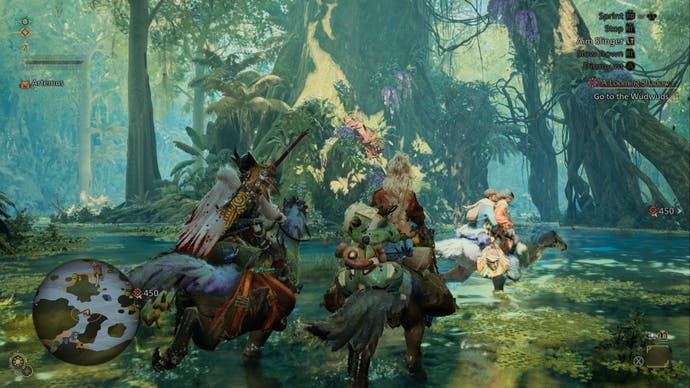
Eventually, biomes grow even more frenetic as Wilds piles on rarer monsters, more exotic combinations. The world enters a state of constant flux, shifting not only from day to night but across changing seasons. Verdant fauna and abundant wildlife make way for fallow periods, before vicious electrical storms, torrential rainfall, and heat waves sweep in to herald a new season of plenty – each change impacting the monsters, endemic life, and other events you’ll see. All this happens in real-time; sandstorms slowly creep across the horizon before engulfing the desert whole, while raindrops turn to torrents, transforming still forest pools into surging currents. Even the corpses seemingly rot over time! Not all biomes are created equal, mind; later areas devolve into a series of rather squalid, indistinct spaces that don’t have quite the same impact or sense of life as Wilds’ early forest and desert biomes. But even so, the engine of movement driving the world makes for something that can be thrillingly dynamic and gloriously unpredictable when it all comes together.
All this frenzied activity is tracked across Wilds’ constantly shifting 3D map, forever festooned with myriad roving icons and incessant event alerts. More than ever, Wilds’ map isn’t just a reference tool; it’s the heart of the experience, with Capcom taking significant steps toward jettisoning the series’ traditional focus on formal quests in favour of a more ad hoc, player-driven approach – one that encourages hunters, whether playing solo or online, to grapple with the ebb and flow of its ever-changing ecosystem on their own terms.
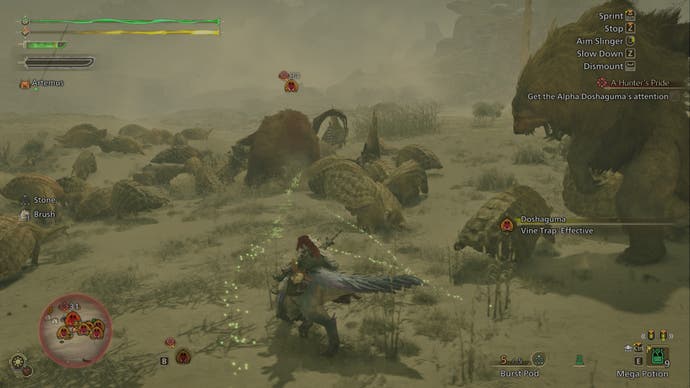
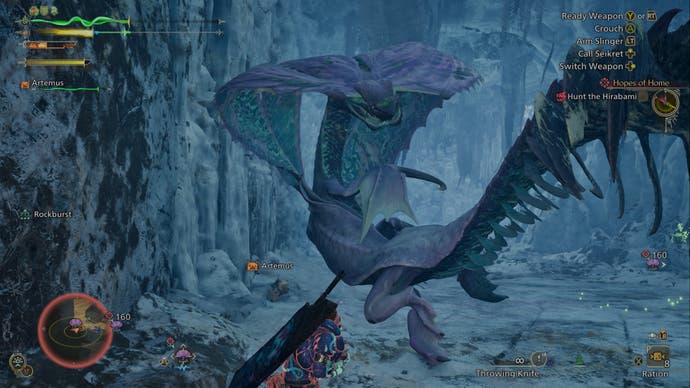
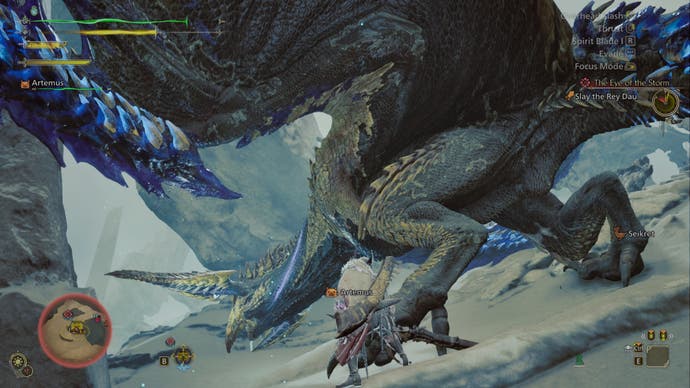
That’s not to say Wilds is completely without structure. The series’ classic Low Rank progression, for instance, has now been streamlined into a linear story campaign, co-existing alongside Wilds’ underlying pick-n-mix field investigations. It’s here where you feel most keenly that Wilds is possibly quietly at war with itself, not quite sure how to balance the demands of returning fans with a desire to woo the untapped masses. The main story campaign is essentially a 20-hour tutorial designed to gently walk players through the fundamentals, but it’s so tortuously belaboured, and covers so little meaningful ground (yup – you’re still going to have to Google “affinity”), it feels approximately 20 times longer than it needs to be. It’s also essentially mandatory given so many of Wilds’ features – from side quests to Palico support skills, and even the game’s flagship seasonal dynamism – don’t unlock till the credits roll and High Rank begins.
To be clear, the story campaign isn’t an entirely terrible way to spend 20 hours, thanks to sky-high production values, infectiously silly detours, and a genuinely endearing cast. But it takes the series’ relatively recent infatuation with cinematic storytelling to fairly exhausting extremes – suffocating its handsomely staged fights between so much endless cutscene jib-jabber and on-rails traversal that even the most receptive of newcomers (let alone old-hands who’ve done this dance countless times before) will likely be screaming for Capcom to shut up and get on with it. And don’t expect the overcautious drip-feed of familiar features to immediately stop once you’re in High Rank either, as it takes a surprisingly long time for Wilds to settle down.
All this would be a bit unbearable, frankly, if the fighting wasn’t so exhilarating. Wilds’ mad alchemy of beautiful monster design, elegantly refined combat, and, yes, that wonderfully dynamic world, is something pretty special. Starting with those monsters, Wilds’ varied menagerie is a triumph. Each creature is imbued with so much personality and presence, such an engagingly distinctive move set, they’re a pleasure to observe even when they’re not trying to rip your face off.
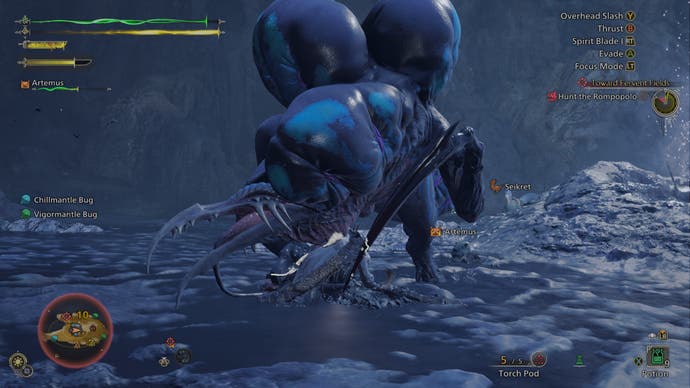
There’s the Quematrice, a wonderfully silly reptilian rooster that merrily peck-peck-pecks its way across the arid Windward Plains; there’s the gloriously named Lala Barina, a spindle-like spider whose skittering, swirling dance intermittently involves shooting paralysing pappi from the rose on its butt. You’ll claw through oily sediment to battle the Rompopolo, an inflatable mosquito that uses its proboscis to blast air up through the ground. And then there’s the Uth Duna, which clomps around beneath an enormous flowing mantle, turning still forest pools into devastating tidal waves. Indeed, it’s a hit rate that’s only slightly undone by the tiresome sub-class of monsters that favours relentless explosive area-of-effect attacks. On the whole, though, its creature design rarely stumbles. Better yet, those unfailingly awful defence-style set-pieces that have dogged the series for generations have finally, mercifully, been given the boot.
There have been smart refinements to combat, too. Admittedly, Wilds isn’t likely to win over anyone who’s so far failed to click with the series’ aggressively combo-based fighting style – which has a tendency to feel a little leaden unless you understand its flow. But it still offers a wonderfully varied toolset for those eager to explore. For starters, all 14 of the series’ complementary core weapons are back, ranging from the pulverising heft of the Great Sword and the swift Dual Blades, to the more exotic likes of the Insect Glaive and the delightfully absurd Hunting Horn. And while there aren’t too many surprises here, various nips and tweaks – particularly to Wilds’ combat-adjacent systems – combine to give the series’ familiar whack-and-dodge rhythms a snappier pace and greater sense of fluidity.
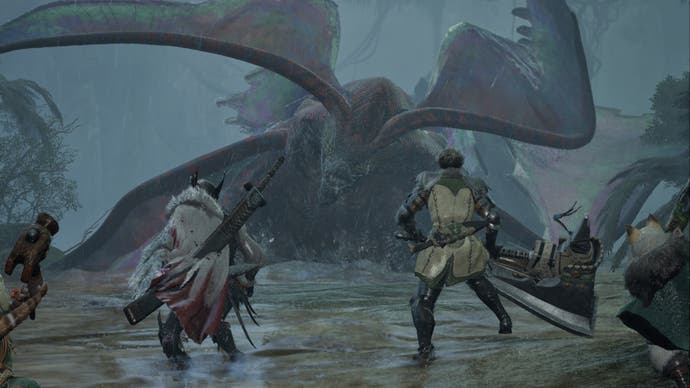
There’s the new Focus system, for instance, giving players the ability to inflict conspicuous “wounds” by wailing repeatedly on specific monster parts. In practical terms, this creates opportunities for increased damage and additional rewards, but on a more psychological level these regular crescendo moments give the series’ traditionally lengthy battles a more tangible sense of progression.
Really, though, it’s the smaller, less showy refinements that help make the difference, all coming together to create a more consistent combat flow. Buff-giving food can now be cooked on the go, for instance (in addition to the series’ familiar meat steaks), and it’s possible to retrieve mid-mission supplies, or switch between a choice of two weapons while riding on your multi-purpose bird-like Seikret (it’s an ongoing travesty Rise’s Palamutes didn’t return, but we can save that conversation for later). All this means less returning to base and more time spent engaged in the thrill of battle – giving Wilds a certain purity of focus the series hasn’t really seen before.
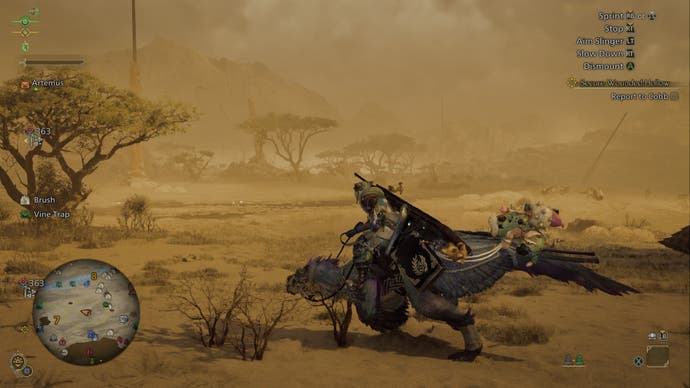
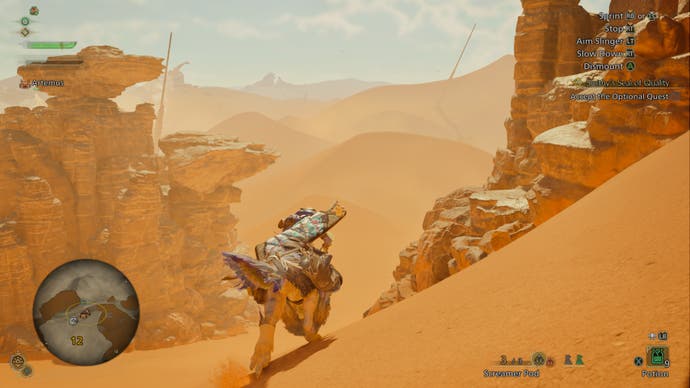
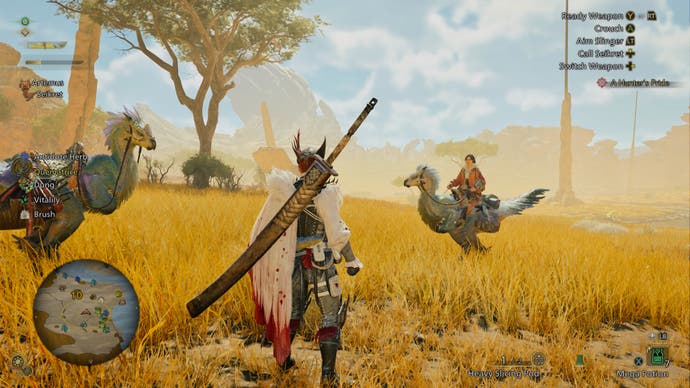
There is, though, the sense Capcom’s obsessive eradication of friction in Wilds isn’t always to its benefit. For instance, it’s surprising just how low Wilds’ difficulty seems to skew, even beyond the cautious early curve of story mode. Granted, I’ve played an awful lot of Monster Hunter in my time, so your own experience may vary, but even with the absolute minimum of gear upgrades, I still haven’t failed a quest some 40 hours in. And with far less reason to engage with the resource grind that’s traditionally been the driving force of the series, it all feels a little insubstantial. There is, too, a niggling sense – albeit not an easy one to pin down – that all this aggressive streamlining is perhaps robbing the series of some of its distinctive personality.
But taking a step back, Wilds remains an exhilarating piece of work – so refined, so alive, so giddily, chaotically joyful when it all comes together that it feels like the ultimate culmination of everything the series has been working toward over the last two decades. And if it continues Monster Hunter’s legacy of generous post-launch support – where the series has traditionally felt the freest to get daft and indulge in its more sadistic tendencies – it’ll be fascinating to see how this beautiful new baseline for the series develops.
A copy of Monster Hunter Wilds was provided for review by publisher Capcom.












Add comment